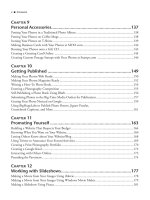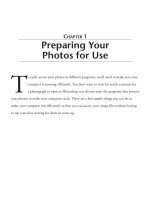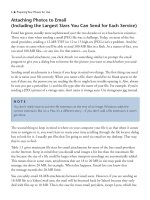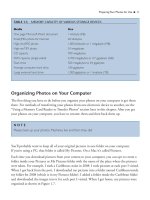101 QUICK AND EASY SECRETS FOR USING YOUR DIGITAL PHOTOGRAPHS- P37 ppsx
Bạn đang xem bản rút gọn của tài liệu. Xem và tải ngay bản đầy đủ của tài liệu tại đây (268.02 KB, 5 trang )
Knowing What You Want on Your Website
One of the biggest challenges of making a website is deciding what content you will have.
To decide that, it’s always a good idea to take a look at what others have done. You want to know
what links are on the homepage; what they sell (including services), if anything; and what other
extras they have. Table 11.1 presents a wide range of photographer websites and the content
they contain.
Notice that there is a trend toward websites that contain blog posts (see Figure 11.2). It makes
sense because when you write a blog post for your webpage, you have fresh content that will
keep people coming back. You’ll find that all the sites have great photo galleries and that some
don’t sell anything. Most of the time, if they’re not selling anything, they’ll have ads to make
money.
166 ■ Promoting Yourself
SELLING IMAGES ON YOUR WEBSITE OR BLOG
RIGHT AWAY WITH PAYPAL
PayPal is a site you can register on that allows your customers to pay for their goods with a
credit card.When the buyer wants an item on your website, he can go to the PayPal site and
pay with his credit card. It’s quick and easy to sell images on your blog using PayPal.You can
make a button for the image that states its name and price and that will link to PayPal so the
customer can use his credit card to buy it. (You can also make multiple-choice buttons that
allow you to sell the same image at different sizes or in black and white versus color.) To make
the button go to PayPal, click on the Merchant Services tab at the top of the page.Then click
Buy Now Button. Fill out the form and then click on Create Button.You’ll be given some
HTML code to put in your blog post (in the HTML section). Put it under the image, and your
image will be for sale. After that, they can click the button and pay, and you can deliver, say, a
high-res image by e-mail.
NOTE
You can make money on your website or blog by putting ads on it. Google
( has an AdSense program where you can put ads on your
site with HTML code. LinkWorth (www.linkworth.com) also has a good program for putting
ads on your site.
TABLE 11.1 PHOTOGRAPHER WEBSITES AND CONTENT
Website Main Homepage Items Sold at Site Ads
Links and Content
Photocritic.org Home, About, All Articles, On About page, link to Google
and Search, as well as blog posts his book on Amazon: Adsense
Macro Photography
Photo Workshop
Tony Sweet Gallery,Workshops, Bio, Fine art prints, notecards, None
Photography Events, Blog, Store DVDs, and books
(Tonysweet.com)
Author Gunther Home, Store, Limited Edition, Fine art prints, Amazon
Photography High Resolution Murals, Contact, limited editions
(aguntherphotography.com) Copyright, Galleries, Links,Tutorials,
Wallpapers (free), as well as daily
blog posts
Jill Greenberg Portfolio, Names None None
(manipulator.com) (she photographs celebrities),
Bio and Press, News, Publications,
Exhibitions/Events, Contact
Wow Photo Art Home, Statement, Reviews, Prints, prints on canvas None
(wowphotoart.com) Exhibits, Buy, Care, Links, Contact
Promoting Yourself ■ 167
Figure 11.2 Many websites today contain blog posts.
Letting Others Know about Your Website/Blog
Once you have your website up and running, how are you going to let people know it’s there?
There are myriad ways to do that—no one way is an easy bullet. It takes time and perseverance
to get people to come to your website and/or blog. In the “Getting Your Photo Noticed on
Google” section in Chapter 10, there is information about one way to get people to come to
your webpage/blog—making filenames for your pictures that the Googlebot can find. If you
recall, when you make a blog or website with an online program such as Blogger or Weebly,
you’ll have to upload the images to that website/blog. The programs convert the insertion of
images into a website/blog into language the web can understand, which is HTML. Here are
some other ways to get your website/blog noticed:
❈
Get popular blogs/websites to link your blog/website to theirs. Many blogs/websites have a
Links section. Your goal is to get to be one of those links. The more links you have, the more
the Googlebot will notice that your site’s out there, and the higher ranking it will give it in
the search results.
❈
Submit your blog/website directly to the search engines. Google’s is at www.google.com/
addurl, and Yahoo!’s is at It’ll cost you, though—
a tidy $299 per year.
❈
When you name the new pages to your website or new posts to your blog, use the right
keywords. In Blogger, it asks you to name your blog as well as describe it. The words count
in your ranking. For example, I named one of my blogs “Digital Traveler.” When you type
those words into Google, my site comes up first (out of some 11 million sites). If your site
comes up number one for the keywords “digital photography,” then you know you’re probably
going to get millions of hits a day. Digital Photography Review (www.dpreview.com) has that
honor; it’s a site you should count on for great reviews about cameras, lenses, and other
photo accessories.
❈
Submit your blog posts, webpage, webpage articles, or even your best images to social book-
marking sites, such as delicious.com, shoutwire.com, and digg.com. People on those sites can
vote on whether they think your submission is a good one.
❈
Keep content fresh. Post on blogs as often as you can and/or add fresh content to your
website. Search engines like to pick up new stuff.
❈
Submit your site to directories such as photo.net and photographydirectory.org.
168 ■ Promoting Yourself
Using Twitter to Announce Your Events/Activities
Keep in mind that getting word about your photography out there will get more people to a
gallery when you have a show, draw more readers to your photography book if you’ve written
one, and send more people to your blog/website to see and either buy your photography or
click on the ads on your site/blog.
Twitter is a social networking site where you post short messages (140 characters max). You can
choose to follow other people by searching for them. (To search, click on Find People at the top
of all Twitter pages.) After you do your search, a list of people will come up with a Follow link.
Just click on that link to follow them. Once you start following people, you’ll find that they’ll
start following you. See Figure 11.3.
Every time you post on your blog or other site and/or find an interesting photo article/blog
post/website, let people on Twitter know. (This is called “tweeting” it.)
If you’re writing a book, you can put out a chapter bit by bit (140 characters max per post) on
Twitter. It’s easy to become a member; just sign up at twitter.com. When you start being active
on Twitter, you’ll find you gather followers quickly.
Promoting Yourself ■ 169
Figure 11.3 An entry on Twitter is called a “tweet.”
Finally, you can link your Twitter posts to your blog. This will put your Twitter posts on your
blog every time you tweet. When you do this, your blog and social networking accounts will be
more active, drawing more interest. To do this, log into Twitter and click on Settings. In the
More Info URL category, click on the link that says You Can Also Add Twitter to Your Site
Here. A new window will come up with a choice of blogs and social networking sites (MySpace,
Blogger, Facebook, and TypePad). Click on one of them and then click on Continue at the
bottom-right part of the window. Last, in the new window, choose the number of updates you
want on your blog and then follow the directions for putting the updates on the blog/social
networking sites you want.
Creating a Print Photography Portfolio
Creating a print portfolio is one of the best things you can do with your photos, which often sit
in your computer without anyone physically seeing them in print form. Printing your images
makes sense because no one knows what will happen to technology in the years to come, possibly
making what’s in your computer today obsolete 20 years from now. (You can review the “What
Will Your Images Look Like in 10 Years?” sidebar in Chapter 1 to see what the possibilities are.)
When you print your photos out, they become a permanent record of what you’ve done. With
today’s archival inks and paper, your printed images are likely to last generations.
170 ■ Promoting Yourself
NOTE
You can let people on Twitter know about photos you post by giving them the URL in your
post. Flickr gives you a URL for each photo you post. Navigate to your homepage and click
on Your Photostream under your image/greeting at the top of the window.Then, in the next
window, click on the picture for which you want the URL. It will appear with a single enlarged
version of your image. Blogger also gives you a URL for each photo you post. (Click on the
photo in your post to get the photo’s URL.)
NOTE
It doesn’t hurt to follow other photographers, too, as you’ll come to find out new techniques
and goings-on in the photography world.









